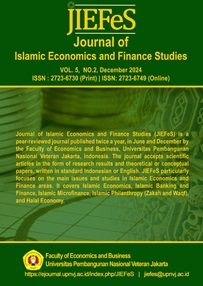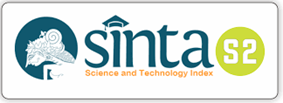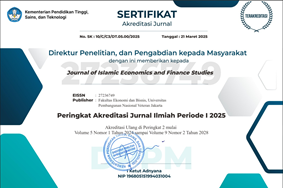The Impact of Islamic Banking on Redistribution of Sustainable Income
DOI:
https://doi.org/10.47700/jiefes.v5i2.9194Keywords:
Income Redistribution, Islamic Banking, Riba, Shariah, Wealth DistributionAbstract
Islamic banking operates within a framework guided by Shariah principles, emphasizing fairness, equity, and social justice. Unlike conventional banking systems that rely on interest-based transactions, Islamic banking prohibits riba (interest) and promotes profit-and-loss sharing. However, income inequality remains a persistent challenge in many Muslim-majority countries, raising questions about how Islamic banking can contribute to sustainable income redistribution. This study employs primary data collected from 400 respondents across four countries where Islamic banking operates: Saudi Arabia, Malaysia, Indonesia, and Nigeria, with 100 participants sampled per country. Data were gathered using structured interviews and analyzed using qualitative and quantitative approaches, supported by a review of literature and case studies. The findings reveal that Islamic banking significantly contributes to wealth redistribution and economic justice through instruments such as zakat, waqf (endowments), and profit-sharing models. The research concludes that Islamic banking is not only a viable alternative to conventional systems but also an essential mechanism for achieving sustainable income redistribution. These findings have significant implications for policymakers, financial institutions, and communities seeking to address income inequality and foster a more equitable economic system.
References
Abdul-Rahman, Y. (2014). The Art of Islamic Banking and Finance: Tools and Techniques for Community-Based Banking. Wiley. https://DOI:10.1002/9781118792551
Ahmad, A. Y. (2016). Does Islamic banking help in economic development of Muslim countries? Journal of Islamic Business Management, 6(2), 19-39.https://mpra.ub.uni-muenchen.de/88387/
Ahmed, H. (2014). Role of Islamic finance in poverty alleviation. Islamic Research and Training Institute. https://api.semanticscholar.org/CorpusID:153520109
Alam, M.M., Shahriar, S.M., Said, J., & Elahi, M.M. (2018). Waqf as a Tool for Rendering Social Welfare Services in the Social Entrepreneurship Context. Global Journal Al-Thaqafah, Special Issue, 87-98. DOI: 10.7187/GJATSI2018-06
Ayuba I.A, Yusuf A.J (2021). Islamic Economic System: A Better Approach to Revive the Nigerian Economy. Conference of Islam in Nigeria, Federal University, Dutse. https://iwf.com.ng/2021_conference_papers/materials_2021/COIN_pp%2034-41.pdf
Bakar, N. A., & Ibrahim, M. A. (2019). Islamic banking and finance: Principles and practical implementation. Islamic Economic Studies, 27(1), 45-67.
Braun, V., & Clarke, V. (2016). Using thematic analysis in psychology. Qualitative Research in Psychology, 3(2), 77-101.
Chapra, M. U. (1985). Towards a Just Monetary System. The Islamic Foundation.
Chapra, M. U. (1992). Islam and the Economic Challenge. Islamic Foundation.
Chapra, M. U. (2016). The Future of Economics: An Islamic Perspective. Islamic Foundation. https://books.google.com.ng/books/about/The_Future_of_Economics.html?id=0NGpDAAAQBAJ&redir_esc=y
Cherroun R. (2021). The role of Islamic Banks in Economic Development. Conference Spaperwww.researchgate.net/publication/351083181_The_role_of_Islamic_Banks_in_Economic_Development
Creswell, J. W., & Plano Clark, V. L. (2018). Designing and Conducting Mixed Methods Research (3rd ed.). SAGE Publications. https://books.google.com.ng/books/about/Designing_and_Conducting_Mixed_Methods_R.html?id=eTwmDwAAQBAJ&redir_esc=y
Dusuki, A. W., & Abozaid, A. (2017). A CRITICAL APPRAISAL ON THE CHALLENGES OF REALIZING MAQASID AL-SHARIAAH IN ISLAMIC BANKING AND FINANCE. International Journal of Economics, Management and Accounting, 15(2), 143-165. https://doi.org/10.31436/ijema.v15i2.133
Dusuki, A. W., & Bouheraoua, S. (2017). The framework of Maqasid al-Shariah and its implication for Islamic finance. Islamic Economic Studies, 19(2), 1-31. https://api.semanticscholar.org/CorpusID:154732074
El-Gamal, M. A. (2016). Islamic Finance: Law, Economics, and Practice. Cambridge University Press.
El-Komi, M., & Croson, R. (2013). Experiments in Islamic microfinance. Journal of Economic Behavior & Organization, 95, 252-269.
Ghosh, A. (2017). How does banking sector globalizaton affect economic growth? International Review of Economics & Finance, 48, 83-97
Grant, K. A., Aziz, O., & Arshed, N. (2019). The impact of entrepreneurial activity on poverty alleviation. Economic and Social Development: Book of Proceedings,215-224. https://www.researchgate.net/publication/333079300_The_Impact_of_Entrepreneurial_Activity_on_Poverty_Alleviation
Haneef, M. A., & Riaz, T. (2022). Zakat and Poverty Alleviation: Assessing Modern Applications. Journal of Islamic Philanthropy, 7(3), 56–74.
Hanif, N., & Arshed, N. (2016). Relationship between school education and economic growth: SAARC countries. International Journal of Economics and Financial Issues, 6(1), 294-300.
Hassan, M. K., & Aliyu, S. (2021). Islamic microfinance: A bibliometric review. Global Finance Journal, 49, 75-86. https://doi.org/10.1016/j.gfj.2021.100651
Hassan, M. S., & Kalim, R. (2017). Stock market and banking sector: Are they complement for economic growth in low human developed economy? Pakistan Economic and Social Review, 55(1), 1-30. https://pu.edu.pk/images/journal/pesr/PDF-FILES/1-v55_1_17.pdf
Hassan, M. S., Bukhari, S., & Arshed, N. (2019). Competitiveness, governance and globalization: What matters for poverty alleviation? Environment, Development and Sustainability (1-28). https://doi:10.1007/s10668-019-00355-y
Iqbal, Z., & Mirakhor, A. (2011). An Introduction to Islamic Finance: Theory and Practice. Wiley. https://books.google.com.ng/books/about/An_Introduction_to_Islamic_Finance.html?id=SbVUt5X0R5MC&redir_esc=y
Ismail, S. M., & Kasim, M. (2023). Reviving Waqf Institutions: Challenges and Prospects in the Digital Era. Journal of Islamic Social Finance, 12(1), 90–105.
Kalim, R., & Arshed, N. (2018). What determines the social efficiency of Islamic banking investment portfolio? Journal of Islamic Business and Management,8(2), 386-406. DOI: 10.26501/jibm/2018.0802-004
Khaleequzzaman M., Shirazi N.S., Obaidullah M., & Rashid M. (2019). Equitable Islamic Finance Research and Training Institute.
La Palta. Alharbi, A. (2015). Development of the Islamic Banking System. Journal of Islamic Banking and Finance, 3(1), 12-25 DOI: 10.15640/jibf.v3n1a2
Mansur, A. (2019). Sharia Banking Dynamics and the Macroeconomic Responses: Evidence from Indonesia. Jurnal Ekonomi Malaysia, 2(53), 1-15. https://mpra.ub.uni-muenchen.de/97883/
Narayan, P. K., & Phan, D. H. B. (2019). A survey of Islamic banking and finance literature: issues, challenges and future directions. Pacific Basin Finance Journal, 53, 484-496. https://doi.org/10.1016/j.pacfin.2017.06.006
Naz, S.A., & Gulzar, S. (2020). IMPACT OF ISLAMIC FINANCE ON ECONOMIC GROWTH: AN EMPIRICAL ANALYSIS OF MUSLIM COUNTRIES. The Singapore Economic Review. https://doi.org/10.1142/S0217590819420062
Obaidullah M. (2008). INTRODUCTION TO ISLAMIC MICROFINANCE, IBF Net Limited, Available at SSRN: https://ssrn.com/abstract=1506072
Parkin, M. (2016). Macroeconomics (12th ed.): Pearson Education.
Report of EY 2016 (PDF) An Appraisal of the Role of Islamic Banking Development and Economic Growth. Available from: https://www.researchgate.net/publication/348457842_An_Appraisal_of_the_Role_of_Islamic_Banking_Development_and_Economic_Growth [accessed Aug 26 2024].
Siddiqi, M. N. (2016). Islamic banking and finance in theory and practice: A survey of the state of the art. Islamic Economic Studies, 13(2), 1-48.
Sohail, H., & Arshed, N. (2020). Cost-Efficiency Analysis of Mudarabah Companies. In Handbook of Research on Theory and Practice of Global Islamic Finance (pp. 568-592). IGI Global.
Syed M., Abdul R.S., Kashif R.,& Shaherbano (2020). The Role of Islamic Finance in Achieving Economic Growth: An Econometric Analysis of Pakistan. https://citations.springernature.com/item?doi=10.1007/978-3-030-39939-9_10
Tabash, M. I., & Anagreh, S. (2017). Do Islamic banks contribute to growth to the economy? Evidence from United Arab Emirates. Banks and Bank Systems,12(1), 113-118.
http://dx.doi.org/10.21511/bbs.12(1-1).2017.03
Usman, M. & Tasie, G. (2019). Impact of Islamic Banking on Income Redistribution in Northern Nigeria. Journal of Islamic Banking and Finance, 6(4), 23-34.
WIEF. (2016). 12th World Islamic Economic Forum. Indonesia.
Downloads
Published
Issue
Section
License
Copyright (c) 2025 Jamiu Adeniyi Yusuf; Rauf Mumini Oladapo, Ayuba Aderole Ismail, Muhammed Azeem Tunde

This work is licensed under a Creative Commons Attribution 4.0 International License.
Authors who publish with this journal agree to the following terms:
- Authors retain copyright and grant the journal right of first publication with the work simultaneously licensed under a Creative Commons Attribution 4.0 International License that allows others to share the work with an acknowledgment of the work's authorship and initial publication in this journal.
- Authors can enter into separate, additional contractual arrangements for the non-exclusive distribution of the journal's published version of the work (e.g., post it to an institutional repository or publish it in a book), with an acknowledgment of its initial publication in this journal.
- Authors are permitted and encouraged to post their work online (e.g., in institutional repositories or on their website) before and during the submission process, as it can lead to productive exchanges, as well as earlier and greater citation of published work.

This work is licensed under a Creative Commons Attribution 4.0 International License.











